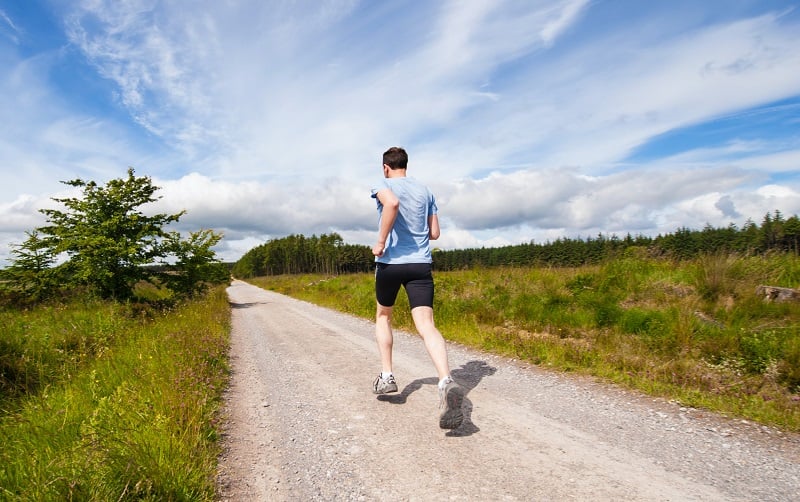How to Start Running (and be successful): A Beginner’s Guide

If you want to build stronger bones, improve your cardiovascular fitness, burn lots of fat, and get in shape quickly, you might want to consider running. While the idea of running can overwhelm, we are going to break down all of the benefits and how to start running (and be successful).
What are the Benefits of Running?
When you’re trying to get in shape, the idea of running may seem daunting. But, if you can focus on all the benefits and ease into a program, you can get into a running program that potentially makes it that much easier to start running.
What are some of these amazing benefits and why should you choose to begin running as a primary form of exercise? Here are a few reasons. Running…
- Improves glucose regulation
- Strengthens your bones and joints as it’s a weight-bearing exercise
- Improves your cardiovascular fitness, lowers blood pressure, and may reduce the risk of death from a heart attack or stroke
- Decreases the risk of cancer
- Boosts memory
- Lowers the risk of neurological diseases like Alzheimer’s and Parkinson’s and reduces cognitive decline as you age
- Relieves stress
- Improves sleep
- Supports mental health
- Builds muscle tone—it’s a great leg workout and also works the core
- Is easily accessible for most people—all you need are some comfy sweat-resistant athletic wear, a pair or two of running shoes, good quality socks, and the open road, trail, or treadmill
- Is easy to learn
- Boosts self esteem
- Lifts mood—yes, the “runner’s high” is a real thing
- Can double as a meditation
- Promotes life and health span
Finally, running requires so many calories, you will burn more calories than you typically would doing another form of exercise. One of the top reasons people start a running program is to lose weight and keep it off. If you’re looking for a big caloric bang for your exercise buck and to save serious time, running is it.
Before You Start Running
Make sure to clear it with your doctor. Running is not necessarily a great idea for everyone. If you are significantly overweight, have certain health conditions or injuries, running may not be the best thing for you in the immediate future. The old saying “You need to walk before you can run,” really does apply to running.
Invest in a good pair of running shoes. Not only will the shoes provide the cushioning and support you’ll need, the right shoe can help properly align your feet, ankles, knees, and hips, so you are less prone to injury.
Always run in a safe manner. If you choose to run outside, run in a safe area or with a buddy. Watch out for traffic if you wear headphones while running, and consider reflective gear if you’re running in the dark (or as it’s getting dark). And wear brightly colored clothes if you’re running near a road. It’s also a good idea to let someone know where you’re running and run in well-lit, populated areas if you’re alone.
And, don’t forget to warm up before you start your run and cool down and stretch after your run.
How to Start Running
One of the best programs out there may be some form of the “Couch to 5K” (C25K) running program. Originally put together by Josh Clark on how to start running, the Couch to 5K program helps beginners become runners over a nine-week period. According to Josh, “The simple idea behind the Couch to 5K program is bridging that gap between walking to jogging and eventually to running.” The premise behind this program is to ease into running for longer and longer intervals over time.
How does it work? You start with simply brisk walking followed by short periods of running. This sequence is repeated several times for a certain length of time of the workout and/or running time is lengthened with each workout.
Over a period of nine weeks, you’ll find yourself gradually working your way up to greater and greater distances and running time periods.
Try This Beginner’s Running Program
Always start running with a solid warm up. You can begin by walking. You’ll also want to separate your running days (not run on consecutive days repeatedly). Start with three running workouts a week, like Monday, Wednesday, and Friday. You can do this program outdoors or on a treadmill, if that is more convenient for you.
Here’s an example:
Week 1, Workout 1
- Walk for 5 minutes
- Run for 15 seconds
- Walk for 2 minutes
- Continue this for 15 minutes
- End with a 5-minute cooldown walk
Week 1, Workout 2
- Walk for 5 minutes
- Run for 30 seconds
- Walk for 2 minutes
- Continue this for 6 rounds (15 minutes)
- End with a 5-minute cooldown walk
Week 1, Workout 3
- Walk for 5 minutes
- Run for 45 seconds
- Walk for 2 minutes
- Continue this for 6 rounds (about 16 minutes)
- End with a 5-minute cooldown walk
Week 2, Workout 1
- Walk for 5 minutes
- Run for 60 seconds
- Walk for 2 1/2 minutes
- Continue this for 6 rounds (about 20 minutes)
- End with a 5-minute cooldown walk
Week 2, Workout 2
- Walk for 5 minutes
- Run for 90 seconds
- Walk for 3 minutes
- Continue this for 5 rounds (about 20 minutes)
- End with a 5-minute cooldown walk
Week 2, Workout 3
- Walk for 5 minutes
- Run for 90 seconds
- Walk for 2 1/2 minutes
- Continue this for 5 rounds (20 minutes)
- End with a 5-minute cooldown walk
Week 3, Workout 1
- Walk for 5 minutes
- Run for 2 minutes
- Walk for 3 minutes
- Continue this for 5 rounds (25 minutes)
- End with a 5-minute cooldown walk
Week 3, Workout 2
- Walk for 5 minutes
- Run for 2 1/2 minutes
- Walk for 3 minutes
- Continue this for 5 rounds (about 25 minutes)
- End with a 5-minute cooldown walk
Week 3, Workout 3
- Walk for 5 minutes
- Run for 2 1/2 minutes
- Walk for 2 1/2 minutes
- Continue this for 5 rounds (25 minutes)
- End with a 5-minute cooldown walk
Week 4, Workout 1
- Walk for 5 minutes
- Run for 3 minutes
- Walk for 2 minutes
- Continue this for 6 rounds (30 minutes)
- End with a 5-minute cooldown walk
Week 4, Workout 2
- Walk for 5 minutes
- Run for 3 1/2 minutes
- Walk for 2 1/2 minutes
- Continue this for 5 rounds (30 minutes)
- End with a 5-minute cooldown walk
Week 4, Workout 3
- Walk for 5 minutes
- Run for 3 1/2 minutes
- Walk for 2 minutes
- Continue this for 5 rounds (about 30 minutes)
- End with a 5-minute cooldown walk
Week 5, Workout 1
- Walk for 5 minutes
- Run for 4 minutes
- Walk for 2 minutes
- Continue this for 6 rounds (about 35 minutes)
- End with a 5-minute cooldown walk
Week 5, Workout 2
- Walk for 5 minutes
- Run for 4 1/2 minutes
- Walk for 2 minutes
- Continue this for 5 rounds (about 35 minutes)
- End with a 5-minute cooldown walk
Week 5, Workout 3
- Walk for 5 minutes
- Run for 5 minutes
- Walk for 2 minutes
- Continue this for 5 rounds (35 minutes)
- End with a 5-minute cooldown walk
Week 6, Workout 1
- Walk for 5 minutes
- Run for 6 minutes
- Walk for 1 1/2 minutes
- Continue this for 5 rounds (about 40 minutes)
- End with a 5-minute cooldown walk
Week 6, Workout 2
- Walk for 5 minutes
- Run for 7 minutes
- Walk for 1 1/2 minutes
- Continue this for 5 rounds (about 40 minutes)
- End with a 5-minute cooldown walk
Week 6, Workout 3
- Walk for 5 minutes
- Run for 8 minutes
- Walk for 1 1/2 minutes
- Continue this for 4 rounds (about 40 minutes)
- End with a 5-minute cooldown walk
Week 7, Workout 1
- Walk for 5 minutes
- Run for 10 minutes
- Walk for 2 minutes
- Continue this for 4 rounds (about 45 minutes)
- End with a 5-minute cooldown walk
Week 7, Workout 2
- Walk for 5 minutes
- Run for 12 minutes
- Walk for 2 minutes
- Continue this for 3 rounds (about 45 minutes)
- End with a 5-minute cooldown walk
Week 7, Workout 3
- Walk for 5 minutes
- Run for 15 minutes
- Walk for 5 minutes
- Continue this for 2 rounds (about 40 minutes)
- End with a 5-minute cooldown walk
Week 8, Workout 1
- Walk for 5 minutes
- Run for 16 minutes
- Walk for 2 minutes
- Continue this for 3 rounds (about 50 minutes)
- End with a 5-minute cooldown walk
Week 8, Workout 2
- Walk for 5 minutes
- Run for 18 minutes
- Walk for 5 minutes
- Continue this for 2 rounds (about 50 minutes)
- End with a 5-minute cooldown walk
Week 8, Workout 3
- Walk for 5 minutes
- Run for 20 minutes
- Walk for 2 minutes
- Continue this for 2 rounds (about 50 minutes)
- End with a 5-minute cooldown walk
Week 9, Workout 1
- Walk for 5 minutes
- Run for 25 minutes
- Walk for 1 minute
- Continue this for 2 rounds (about 55 minutes)
- End with a 5-minute cooldown walk
Week 9, Workout 2
- Walk for 5 minutes
- Run for 27 minutes
- Walk for 1 minute
- Continue this for 2 rounds (55 minutes)
- End with a 5-minute cooldown walk
Week 9, Workout 3
- Walk for 5 minutes
- Run for 30 minutes
- Walk for 1 minute
- Continue this for 2 rounds (about 60 minutes)
- End with a 5-minute cooldown walk
After nine weeks, you can now call yourself a runner! Just remember to take the time to stretch after every workout. And for better results, add some type of strength-training workouts on days when you’re not running. You can also choose other forms of cross training like swimming, cycling, yoga, or Pilates, which will decrease the risk of injury, engage other muscles in the body, increase flexibility and core strength, and provide variety.
Finally, always listen to your body. If you feel like you’re doing too much too fast, slow down. If you need to, you can always repeat a workout. If your runs are way too easy, push yourself a bit harder after the first week or two (to make sure your body is acclimated to running regularly).
You’ll also want to avoid the risk of an overuse injury. To help protect your body for running, invest in good running shoes and change out your shoes regularly as they show mileage.
Enjoy the open road!





 7 Signs Your Body is Seriously Low on Collagen (not just wrinkles)
7 Signs Your Body is Seriously Low on Collagen (not just wrinkles) Health Expert: "Turmeric Doesn't Work (unless...)"
Health Expert: "Turmeric Doesn't Work (unless...)" 3 Warning Signs Your Probiotic Supplement is a Total Waste
3 Warning Signs Your Probiotic Supplement is a Total Waste

